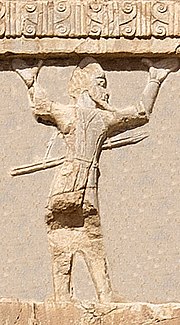Suratian civilization: Difference between revisions
mNo edit summary |
mNo edit summary |
||
| Line 11: | Line 11: | ||
* The Suratii tribes were very linguistically and culturally diverse and when they became homogenized into a singular civilization - many of their cultural identities were lost. | * The Suratii tribes were very linguistically and culturally diverse and when they became homogenized into a singular civilization - many of their cultural identities were lost. | ||
* The Suratii tribes were as mercantile as they were warlike | * The Suratii tribes were as mercantile as they were warlike | ||
== History == | |||
The Suratii were a group of nomadic tribes indigenous to Western Sarpedon. Due to as of yet unknown circumstances, they migrated en masse across the continent and into the mountainous south-eastern part of the continent. There, they interacted with Latinic civilizations. Through these interactions, the Suratii learned concepts such as writing, agriculture, mathematics, and basic astronomy. | |||
[[Category:History]] | [[Category:History]] | ||
[[Category:Chrobonsk]] | [[Category:Chrobonsk]] | ||
[[Category:IXWB]] | [[Category:IXWB]] | ||
Revision as of 18:13, 21 January 2024

This article is a work-in-progress because it is incomplete and pending further input from an author. Note: The contents of this article are not considered canonical and may be inaccurate. Please comment on this article's talk page to share your input, comments and questions. |
The Suratians were a Classical civilization that existed alongside both the first Caphiran Republic as well as the first Caphiran Imperium. Much of what scholars know about the Suratian civilization comes with the cooperation of the Caphiran government as well as cross examination with ancient Caphiran records.
The Suratii were comprised of approximately two hundred distinct tribes that interacted throughout Southern Sarpedon. They eventually homogenized into a single de Jure entity that we now refer to as Suratia. While there were many linguistic differences between the Suratian tribes - they did share a handful of cultural similarities. Paramount of which was their religious pantheon and folklore. They were also very fond of horses and were noted by Caphiran records at the time as being quite skilled Hit and Run fighters.
Many of Chrobonsk’s National epics were written during this time, the most famous of which is “En Ektus”. The Suratian Civilization is also incredibly well preserved. Archaeologists have unearthed entire Suratian villages in the southern part of the nation. Srimonsk was at one point the capital of the Suratian Civilization known as Kaktan. Many archaeological endeavors have been made to excavate more of the ancient city. One of Srimonsk’s most well preserved ruins is the Fortress of Kaktan - which was preserved in the 1500’s to maintain the Chrobonskian national identity and cultural heritage.
- The Suratian Civilization arose after a single powerful tribe united all of the other warring tribes and fought against Caphirian influence in South Sarpedon.
- The conflict against Caphiria is the source of many epics
- There was a legendary tribal leader that is still considered to be a hero today in Chrobonsk
- The Suratii tribes were very linguistically and culturally diverse and when they became homogenized into a singular civilization - many of their cultural identities were lost.
- The Suratii tribes were as mercantile as they were warlike
History
The Suratii were a group of nomadic tribes indigenous to Western Sarpedon. Due to as of yet unknown circumstances, they migrated en masse across the continent and into the mountainous south-eastern part of the continent. There, they interacted with Latinic civilizations. Through these interactions, the Suratii learned concepts such as writing, agriculture, mathematics, and basic astronomy.